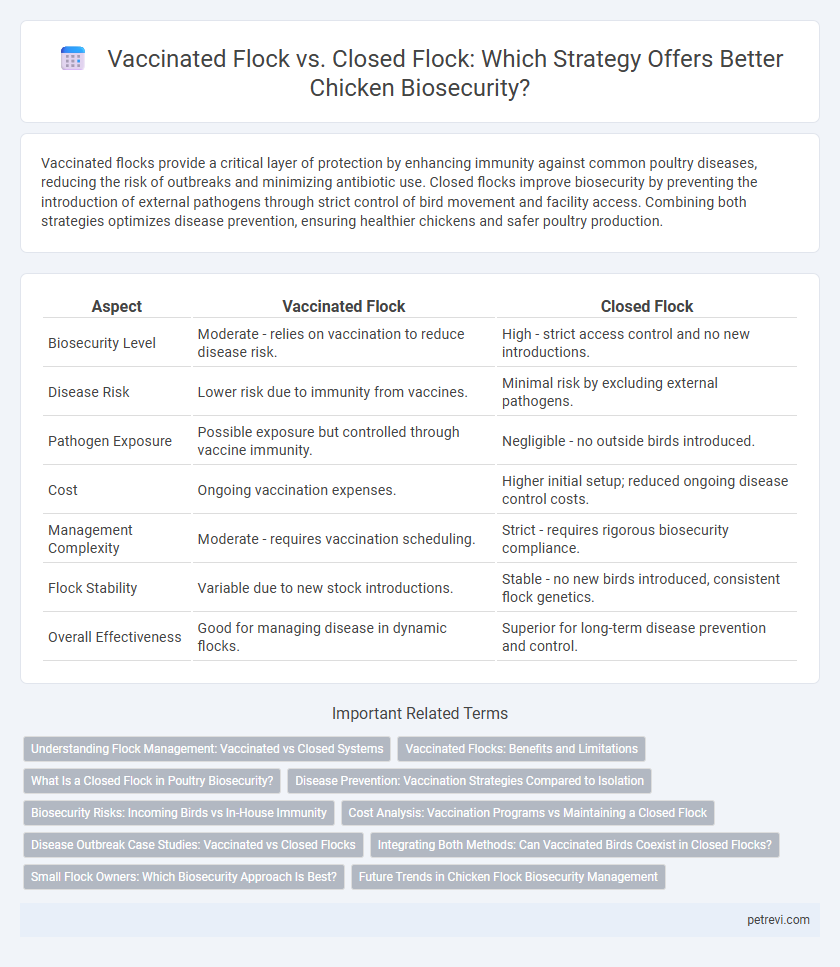Vaccinated flocks provide a critical layer of protection by enhancing immunity against common poultry diseases, reducing the risk of outbreaks and minimizing antibiotic use. Closed flocks improve biosecurity by preventing the introduction of external pathogens through strict control of bird movement and facility access. Combining both strategies optimizes disease prevention, ensuring healthier chickens and safer poultry production.
Table of Comparison
| Aspect | Vaccinated Flock | Closed Flock |
|---|---|---|
| Biosecurity Level | Moderate - relies on vaccination to reduce disease risk. | High - strict access control and no new introductions. |
| Disease Risk | Lower risk due to immunity from vaccines. | Minimal risk by excluding external pathogens. |
| Pathogen Exposure | Possible exposure but controlled through vaccine immunity. | Negligible - no outside birds introduced. |
| Cost | Ongoing vaccination expenses. | Higher initial setup; reduced ongoing disease control costs. |
| Management Complexity | Moderate - requires vaccination scheduling. | Strict - requires rigorous biosecurity compliance. |
| Flock Stability | Variable due to new stock introductions. | Stable - no new birds introduced, consistent flock genetics. |
| Overall Effectiveness | Good for managing disease in dynamic flocks. | Superior for long-term disease prevention and control. |
Understanding Flock Management: Vaccinated vs Closed Systems
Vaccinated flocks rely on immunization protocols to prevent common poultry diseases, enhancing flock immunity and reducing mortality rates. Closed flock systems emphasize strict biosecurity by limiting external exposure, avoiding new introductions, and minimizing disease risks through controlled environments. Effective flock management integrates vaccination schedules with closed system practices to optimize health outcomes and productivity in chicken production.
Vaccinated Flocks: Benefits and Limitations
Vaccinated flocks provide targeted immunity against specific poultry diseases like Newcastle disease and avian influenza, reducing mortality and improving flock productivity. Vaccination enhances overall biosecurity by limiting the spread of pathogens within and between farms, but does not eliminate the risk of infection entirely, necessitating ongoing biosecurity measures. Limitations include vaccine failure due to improper administration, antigenic variation of pathogens, and the cost and logistics of maintaining vaccination programs.
What Is a Closed Flock in Poultry Biosecurity?
A closed flock in poultry biosecurity refers to a chicken population that is maintained without introducing new birds from external sources, minimizing the risk of disease transmission. This method enhances biosecurity by preventing exposure to pathogens commonly brought in by new or replacement birds. Vaccinated flocks rely on immunization to protect against diseases, while closed flocks focus on strict population control and isolation to maintain health status.
Disease Prevention: Vaccination Strategies Compared to Isolation
Vaccinated flocks benefit from targeted immunization against specific poultry diseases such as avian influenza and Newcastle disease, significantly reducing morbidity and mortality rates. Closed flocks enhance biosecurity by minimizing pathogen introduction through stringent isolation measures, effectively preventing exposure to external infectious agents. Combining vaccination protocols with closed flock management offers a robust defense system, optimizing disease prevention and flock health sustainability.
Biosecurity Risks: Incoming Birds vs In-House Immunity
Vaccinated flocks rely on in-house immunity to reduce susceptibility to common pathogens, but they remain vulnerable to biosecurity risks posed by incoming birds carrying novel diseases. Closed flocks minimize exposure by limiting bird introduction, thereby enhancing disease barrier effectiveness and maintaining a pathogen-free environment. Balancing vaccination strategies with strict control of new bird entry is essential for optimizing biosecurity and minimizing the risk of disease outbreaks in poultry operations.
Cost Analysis: Vaccination Programs vs Maintaining a Closed Flock
Vaccinated flocks incur direct expenses such as vaccine procurement, administration labor, and potential productivity losses during vaccination periods, while closed flock systems demand higher initial biosecurity investments to prevent disease introduction and ongoing costs for strict facility controls. Cost analysis reveals that vaccination programs often offer a scalable and flexible approach to disease management, reducing clinical outbreaks and mortality, which can offset vaccine expenses over time. Conversely, maintaining a closed flock minimizes exposure risks but may limit genetic diversity and require costly quarantine measures, making long-term financial sustainability dependent on the farm's biosecurity rigor and disease pressure.
Disease Outbreak Case Studies: Vaccinated vs Closed Flocks
Studies comparing disease outbreaks in vaccinated flocks versus closed flocks reveal that vaccinated flocks demonstrate reduced severity and incidence of viral infections such as Newcastle Disease and Avian Influenza. Closed flocks, which limit external bird introductions, effectively minimize exposure but may remain susceptible to endemic pathogens without vaccination protocols. Integrating vaccination with strict biosecurity measures in closed flocks provides enhanced protection and reduces the risk of large-scale disease outbreaks.
Integrating Both Methods: Can Vaccinated Birds Coexist in Closed Flocks?
Integrating vaccinated birds into closed flocks enhances chicken biosecurity by combining the immunity benefits of vaccination with strict access control measures. Vaccinated birds reduce the risk of disease outbreaks, while maintaining a closed flock limits pathogen introduction through external contacts. This dual approach synergizes to create a robust barrier against infectious diseases in poultry production systems.
Small Flock Owners: Which Biosecurity Approach Is Best?
Vaccinated flocks offer targeted protection against specific poultry diseases, reducing mortality and improving overall flock health, making them ideal for small flock owners seeking proactive disease management. Closed flocks, by limiting introduction of new birds and external pathogens, emphasize prevention and stability through strict biosecurity measures without depending on vaccination. Small flock owners benefit most by combining vaccination protocols with a closed flock strategy, enhancing immunity while minimizing exposure risks for optimal biosecurity.
Future Trends in Chicken Flock Biosecurity Management
Vaccinated flocks demonstrate enhanced resilience against infectious diseases, reducing reliance on chemical treatments and improving overall flock health sustainability. Closed flock systems minimize external pathogen exposure by restricting bird movement and visitor access, fostering a stable biosecure environment that limits disease introduction risks. Future trends emphasize integrating advanced vaccination protocols with stringent closed flock biosecurity measures, supported by technological innovations like real-time health monitoring and automated bio-containment systems to optimize disease prevention in poultry farming.
Vaccinated Flock vs Closed Flock for Chicken Biosecurity Infographic

 petrevi.com
petrevi.com